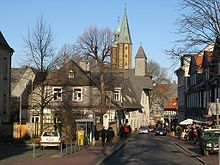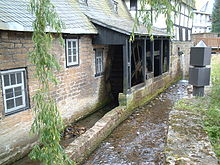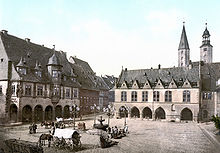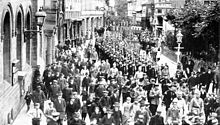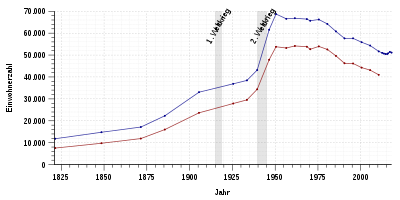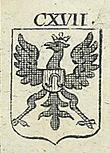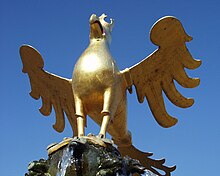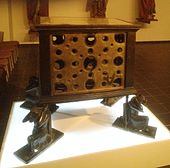Goslar
| coat of arms | Germany map | |
|---|---|---|
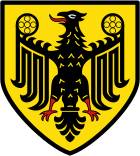
|
Coordinates: 51 ° 54 ' N , 10 ° 26' E |
|
| Basic data | ||
| State : | Lower Saxony | |
| County : | Goslar | |
| Height : | 255 m above sea level NHN | |
| Area : | 163.71 km 2 | |
| Residents: | 50,554 (Dec. 31, 2019) | |
| Population density : | 309 inhabitants per km 2 | |
| Postcodes : | 38640, 38642, 38644, 38690 | |
| Primaries : | 05321, 05325, 05324 | |
| License plate : | GS, BRL, CLZ | |
| Community key : | 03 1 53 017 | |
| LOCODE : | DE GOS | |
| City structure: | 18 districts | |
City administration address : |
Charley-Jacob-Str. 3 38640 Goslar | |
| Website : | ||
| Lord Mayor : | Oliver Junk ( CDU ) | |
| Location of the city of Goslar in the district of Goslar | ||
Goslar is a large independent city in Lower Saxony and the district town of the Goslar district . As of December 31, 2019, it had 50,554 inhabitants.
The mining town , first mentioned in 979, became the seat of an imperial palace around the same time and continued to develop into a town until the 13th century. In 1290, Goslar gained imperial immediacy and retained the status of an independent imperial city in the Holy Roman Empire until it was mediatized in 1802 , which is reflected in the city's coat of arms.
The old town of Goslar and the lying on the southern outskirts former ore mine Rammelsberg count since 1992 under the name Mines of Rammelsberg, Historic Town of Goslar and Upper Harz Water to the World Heritage Sites of UNESCO .
geography
location
The city lies between the northwestern foothills of the Harz Mountains with the Rammelsberg and the extreme southern end of the Salzgitter ridge . Goslar is bounded in the west by the Steinberg and in the east by the border with Saxony-Anhalt . In the northeast of the city lies the Harly Forest . Through the urban area that flows Oker and their tributaries Gose or Abzucht and the wheel .
The municipality of Liebenburg borders in the north , the municipality of Schladen-Werla ( district of Wolfenbüttel ) and the city of Osterwieck (in the district of Harz , Saxony-Anhalt ) in the north-east, the town of Bad Harzburg in the southeast , and the mountain and university town of Clausthal in the south -Zellerfeld (with the community-free area Harz (district Goslar) in between) and in the west the town of Langelsheim .
The closest larger cities are in the north-west Hildesheim (45 km), in the north Salzgitter (30 km), in the north-east Wolfenbüttel (30 km) and Braunschweig (40 km) as well as in the east Magdeburg (90 km), in the south-east Nordhausen (50 km) and in the southwest of Göttingen (55 km).
|
Hildesheim 40 km |
Wolfenbüttel 30 km |
Helmstedt 50 km |
|
Bad Gandersheim 28 km |

|
Wernigerode 25 km |
|
Göttingen 55 km |
Osterode am Harz 25 km |
Nordhausen 50 km |
* Distances refer to the distance (as the crow flies) to the town center.
City structure


Core city (29,624 inhabitants):
- Old town
- Bass violin
- Georgenberg with Kattenberg
- Jürgenohl with Kramerswinkel
- Ohlhof with Gut Ohlhof
- Rammelsberg with Siemensviertel and Rosenberg
- Steinberg
- Sudmerberg
From 1972 incorporated districts with population:

As of June 30, 2018
story
Beginnings
The Harz has been an important ore mining area since Roman times . Therefore, settlements arose here, in which the ore was processed into metals and refined. Archaeological finds from England show that many Anglo-Saxon grave goods, such as a sword found in London, were made from metal from the Harz ore. The earliest evidence of the mining and smelting of Rammelsberg ore could be dated to the 3rd century AD thanks to the archaeological excavations at the Düna manor .
Probably from several settlements located in the Auetal of the Harz river “Gose” on the northern edge of the Harz, originally designated with the field name “Goslar”, the place slowly emerged from written sources from the 10th century. Around the year 1000 the field name was adopted as the place name. The first documentary mention of Otto II is only documented for the year 979. 934, however, a royal castle was probably built on the Georgenberg, although both the written source and the location of the castle at this point are disputed; Archaeological and architectural historical findings are currently being discussed controversially. The coal and steel workers settled in the mountain village around the church of St. Johannis. The Otto Adelheid pfennigs minted from Goslar silver are evidence of improving technology in mining. From the end of the 10th century, silver was also extracted from ore in Goslar in addition to copper mining. The metallurgy industry, which started early and was becoming more and more technologically demanding, required skilled workers. Presumably such experts, who were called "Franks" by the local Saxons, came to Goslar and settled on the so-called "Frankenberg".
Goslar Imperial Era
In 1009, with the first imperial synod under Heinrich II, the important period for Goslar as a central palace of the Holy Roman Empire began . The Palatinate was probably still on the Georgenberg. Heinrich II held further court days and synods in Goslar in 1015, 1017 and 1019, and Heinrich II's stay in Goslar has been documented seven times. The Palatinate Goslar gradually displaced the Palatinate Werla , which was abandoned by the emperors from outside the country because of its importance for the Saxon nobility. Goslar's development into one of the centers of the empire reached its climax under the Salians .
Konrad II is said to have celebrated Christmas in Goslar as early as his king ride in 1024, and in 1025 he laid the foundation stone for the Kaiserpfalz at the current location . Konrad also confirms the rights of the Goslar long-distance trade merchants. Konrad has booked a total of six stays in Goslar.
Under Henry III. his favorite Palatinate in Goslar developed into the center of the empire: In 17 years of government, 18 court days, often lasting several months, were held in Goslar. In 1042 Heinrich III. Peter of Hungary and an embassy from Jaroslav of Kiev . In the following years he installed many bishops and dukes from Goslar . In 1045 Queen Agnes donated the Petersstift . In 1051 the collegiate church of St. Simon and St. Judas was consecrated by Archbishop Hermann von Köln, which then developed into an important training center for the imperial episcopate . At the same time, the Palatinate was expanded to include the representative hall structure of the Aula Regis. On November 11, 1050, Heinrich IV was born in Goslar . In September 1056 Pope Viktor II visited Henry III. in Goslar and rededicated the collegiate church. This meeting manifested the unity between emperor and pope in the sense of civitas dei for the last time . After his death, a few weeks later, the heart of Henry III. buried in the Goslar collegiate church of St. Simon and St. Judas.
Under Henry IV, Goslar's importance for the Salians remained unbroken. A total of 30 stays by the emperor are documented. In 1063 there was a ranking dispute between Abbot Wideradus of Fulda and Bishop Hezilo of Hildesheim in the collegiate church of St. Simon and St. Judas , which ended with a bloodbath in the church under the eyes of the helpless Heinrich IV (" Blutpfingsten "). Heinrich IV installed the first imperial bailiff for Goslar as his representative in the administration of the royal estate . When the king's imperial policy and his long stays in Goslar, which were very expensive for the country, turned the Saxon nobility against him, the situation at the princes' assembly in Goslar escalated to the uprising of the Saxons in 1073 . In the turmoil that followed, Goslar clung to the opposing party. In 1077, for example, a prince's day was held in Goslar under the rival king Rudolf von Rheinfelden . In 1081 Hermann von Salm was anointed (counter) king in Goslar. In 1105 Heinrich V convened a state parliament against his father in Goslar.
In the 12th century the city had reached about the size of today's old town and with the church cross made up of seven churches, the city fortifications and the ensemble of collegiate church and the Palatinate formed a residential city that chroniclers dubbed "Northern Rome". Goslar was first referred to as a civitas (city) in 1075 .
Heinrich V held six diets in Goslar during ten stays. Even under Lothar III. von Süpplingenburg , Konrad III. and especially under Friedrich I. Goslar remained a preferred Palatinate. In 1136 a fire destroyed a third of the city. Around 1150 the Raths-Tiefsten-Stollen was completed to drain the Rammelsbergwerk.
1152 enfeoffed Frederick I. Henry the Lion with Goslar Reichsvogtei. In 1158 the emperor gave the Goslar citizens the "Kaiserforst". In 1167 Goslar was besieged unsuccessfully by Heinrich the Lion. In 1173 Friedrich I refused in Goslar the enfeoffment with the city requested by Heinrich the Lion in return for allegiance in the Italian campaign. Goslar and the Rammelsberg remained plaything in the conflict between the cousins until the lion was outlawed. In the war that followed, Goslar was horrified by the Emperor in 1180 from the siege by Heinrich the Lion. The lion had the huts and pits destroyed, which is why mining had to cease until 1209.
With Heinrich VI. Goslar's importance as a Palatinate decreased. King Otto IV besieged Goslar in 1198/99, but had to withdraw from Philip of Swabia . In 1206 Goslar was stormed and sacked by Gunzelin von Wolfenbüttel , a follower of Otto IV., Allegedly through betrayal of the dominatrix of the Neuwerk monastery .
During the reign of Frederick II , the last Reichstag took place in Goslar, where a compromise between the Staufers and Welfen was found. With the visits of Wilhelm von Holland in the years 1252 and 1253 Goslar's time as royal palace ended.
Late Middle Ages
With the withdrawal of the emperors from the northern part of the empire, the upswing towards urban independence began. After the Goslar city rights, which arose from the rights for long-distance merchants from 1025, were granted, the council, first mentioned in 1219, endeavored to constantly recognize the rights and expand the city's powers. The merchants who advised the ministerial nobility became increasingly self-confident. The focus of the efforts was the acquisition of the mountain and bailiwick rights.
Since 1235, due to a lack of drainage technology, the mining industry on the Rammelsberg has been in a crisis that has led to a pure reduction in reading . The copper trade was maintained, but the income decreased. The word guild used this weakness of the mining industry to expand its political power within the council.
From 1267 to 1566 Goslar belonged to the Hanseatic League of Towns and Merchants . The Alte Harzstraße also dates from this time at the latest . However, Goslar used the Hansa more as a political instrument to assert itself against its neighbors than to make profits from long-distance trade. The preservation of internal order and the constitution of the council was a particular concern of Goslar's Hanseatic policy. When Goslar no longer saw itself adequately protected, it withdrew in favor of regional alliances. The copper and silver trade was particularly important for Goslar, but also beer exports since the 13th century . From 1323 the slate mining and from 1468 the vitriol production is documented. Trade with cities in the region, Saxony, Thuringia and Cologne was particularly important, which is why Hanseatic trade never had the highest priority for Goslar.
Imperial city
In 1290 the council succeeded in getting the most important bailiwick rights transferred. Goslar was now a free imperial city . The council and guilds also agreed in a settlement on a composition of the council of merchants , minters , shopkeepers , bakers , shoemakers and bone-carvers . In addition, the Montanen ( miners ) and Silvanen ( forest workers ) and with them the mountain village were bound to the city. Institutions like the six men of the Silvanen and Montanen were gradually absorbed into the council. Major constitutional battles did not occur again until 1460, as the small guilds and commons wanted to participate in political power. In the mill and hall dispute from 1290 to 1293, the council was able to assert itself against the monasteries and monasteries and suppress the ecclesiastical influences in the city.
With the granting of military shield rights by Ludwig IV in 1340 , Goslar's rights were expanded to include passive feudal rights . In 1348 and 1413 the last bailiwick powers were granted to the city. From 1366 the Vogt was only a city official. Around 1340 the Goslar city law was codified in five books. Goslar law continued to shine beyond the city limits and was adopted by other cities. In legal doubts, Goslar became a respected jury member.
Plague epidemics raged in 1348, 1376 and 1377. However, there were no pogroms or other excesses.
The 1235 the Braunschweiger Guelph devolved and 1296 of the Knights of the Gowische pledged Mountain jurisdiction and the mountain decade have been adopted by the six men in 1356 and went from this to the Council on. In 1359 the Goslar mining law was created. As a result of this development, the council tried from 1360 to find a solution to the drainage issue in order to reactivate the mining industry, which had meanwhile almost come to a standstill. In 1407, 1418 and 1432 the council tried to swamp the pits together with external investors and various miners. Claus von Gotha had a partial success with the Heinzenkunst from 1453 to 1456 . By 1471, the mining industry had recovered to such an extent that the council introduced new taxes for the trades and finally bought all of the owners' shares. From 1478, the smelting of metals was also facilitated by the new Seiger process. Attempts by the Brunswick dukes to redeem the pledge for the Rammelsberg were prevented by the city in 1477 and 1484. Goslar experienced a great boom due to the income from the mine and smelters. By 1511, the council managed to become the sole owner of all mines on the Rammelsberg.
In the 14th century, Goslar was one of the very few cities that could provide all house plots with a water pipe connection using a wooden pipe system, so that the kitchens had running water and did not have to fetch it from a well.
As a result of the rampant robber barons and feuds in the 15th century, Goslar expanded its fortifications until 1519 and participated in various alliances or took up arms himself. The von Schwichelt family proved to be dogged opponents in the Harzburg in 1411/12, in Wiedelah and Lutter in 1427 and in a feud between the nobility in 1472. Likewise, the dukes of Brunswick always posed new dangers. Goslar participated in protective alliances and provided help for cities oppressed by civil unrest or robbers. The Saxon Association of Cities proved to be particularly important . Furthermore, the city tried to hold neighboring princes accountable by means of protection treaties.
Around the year 1520 Goslar was an aspiring city that knew how to expand its territory and its rights. From mountain, hut and forest income a prosperity arose, which was also reflected in the brisk construction activity in the city center.
The Reformation and the conflict with Duke Heinrich d. J.
Having become aware of the flourishing mining industry and being able to do so through the profits from the Hildesheim collegiate feud, Duke Heinrich d. In 1527, J. von Braunschweig-Wolfenbüttel returned the pledge sum for mountain court and mountain tithes (24,663 guilders ) and took possession of the Rammelsberg and a large part of the forests that he had already released for Braunschweig-Wolfenbüttel . The resistance to the Duke's action resulted in a guerrilla war between Goslar and the Guelphs that continued until 1552 . The city filed a lawsuit against the Duke with the Reich Chamber of Commerce , which was largely upheld in 1528.
When Heinrich d. J. moved with an army in front of the city, there were riots against ducal servants in 1527 and the destruction of the monasteries of St. Georg, St. Peter and Zum Heiligen Grabe outside the walls as well as the church of St. Johannes in the mountain village ( Goslar riots 1527 ). Because of this destruction of Heinrich d. J. strained proceedings for breach of the peace finally led to the imposition of the 1540/1541 imperial ban against Goslar.
After the Reformation was introduced in 1526 under the impression of external threat after bitter resistance from the council faction loyal to the emperor, the council summoned Nikolaus von Amsdorf to Goslar in 1528 and set up a municipal Latin school under his direction . In 1531 Amsdorf drafted the first church ordinance.
The conflict with the duke came to a head as the duke ignored instructions and mediation attempts by the emperor and empire and used violence against the citizens of Goslar. Through his intermediaries, he led feuds and blockades against the city and had Goslar Reichstag delegates such as Dr. attacked by Dellingshausen and kidnapped.
Goslar no longer saw itself adequately protected by the emperor and therefore joined the Schmalkaldic League in 1536 , which gave Goslar a short break. When Duke Heinrich d. In 1540 entrusted with the implementation of the imperial ban, even after the repeal of the same against Goslar, the Schmalkaldic League intervened and occupied the Duchy of Braunschweig-Wolfenbüttel . The leaders of the Schmalkaldic Federation propagated the victory of the Federation over the Duke of Braunschweig with their Schmalkaldic Bundestalers minted in Goslar . With the victory of Emperor Charles V near Mühlberg in 1547, however, this protection ceased, so that Heinrich d. J. resumed the reprisals against Goslar and was able to besiege the city with 17,000 men in 1552. After the first bombardment, negotiations took place, at the end of which the Riechenberg contract resulted in the city renouncing the mining tithes, courts, pre-emptive rights and large parts of the forests.
From the Riechenberg Treaty to the end of imperial immediacy

As a result of the Riechenberg Treaty, Duke Heinrich d. J. and from 1568 his son Duke Julius with head administrator Christoph Sander changed the Lower Harz mining and metallurgy from an economic point of view. In this process, the city of Goslar was gradually displaced as a trade from the mining and metallurgical industry. With the inheritance of the Raths- Tiefsten -Stollen by the Tiefen-Julius-Fortunatus-Stollen and the purchase or relocation of the huts by the Duke until 1575, the city lost further sources of income. The vitriol boiling remained a lucrative business for the council until this was also restricted by the duke in 1556. The Goslar beer became another important economic mainstay. Attempts by the Brunswick dukes to incorporate Goslar into their territory, i.e. to transform it from the protectorate that had existed since 1552 into direct rule, were decidedly rejected by the Goslar residents in 1582, 1605/06 and 1614/15. In 1580, the city council signed the Lutheran formula of 1577.
Between 1530, when the first recorded witch trial against Venne Richerdes took place, and 1657, around 28 people were victims of the witch hunt .
1600–1647 Magister Johannes Nendorf was rector of the council school ; He made sure that, in addition to the citizens' sons, regional aristocratic sons, as well as Swedes and Livonians, attended the school.
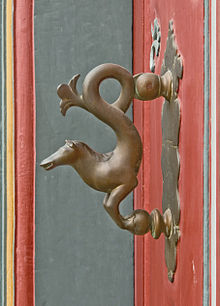
During the Thirty Years' War , Goslar initially tried to maintain neutrality , but tended more towards the imperial party. On February 4, 1622, in connection with the rise in the price of the “ Kipper-Wipperzeit ”, an uprising led by the Leineweber against the city regiment, which could be arbitrated at the last moment, nevertheless led to attacks against the Münzer and the Jews ; the mint master Hans Laffers was finally dismissed in 1625. The attempts of Christian d. J. von Braunschweig-Wolfenbüttel to seize the city on the night of March 5 and March 15, 1626 were refused. Instead, the council and especially the mayor Henning Cramer von Clausbruch kept in touch with Count Tilly , Albrecht von Wallenstein and the court in Vienna, on the one hand to protect the city from damage and on the other hand to achieve a revision of the Riechenberg Treaty. As part of the edict of restitution in 1629, the monasteries were returned to the Catholic order and in 1630 the cathedral monastery and imperial house were transferred to the Jesuits , who began building a college there . With the advance of Gustav II Adolf , Goslar was occupied by Swedish troops from 1632 to 1635. In the negotiations between Emperor Ferdinand III. and Duke August von Braunschweig , which ended in the Goslar Accord of January 16, 1642, Goslar's loyalty to the emperor was not rewarded; the Rammelsberg stayed with the Guelphs.
In 1655 new chancellery regulations were issued that were intended to minimize the number of processes and their duration. Smoldering conflicts between citizens who were not involved in the council and the city regiment led to constitutional battles over participation in the council from 1666 onwards, which should be settled with a settlement made by the mediator Theobald Freiherr von Kurzrock. Despite the establishment of the community council, the settlement did not bring about the expected compensation.
Goslar was only involved in the wars of the 18th century through taxes and the billeting of troops. There was no destruction by soldiers or war. Attempts by the Brunswick dukes to seize the city beyond the inheritance protection treaty were rejected.
Victories of the imperial party and the enthronement of the respective emperors were celebrated with pomp in Goslar. The homage to Joseph I in 1705 was received by Count Schwarzburg in Goslar and led through the festivities to the city's temporary insolvency.

(drawing by Georg Melchior Kraus for Johann Wolfgang von Goethe )
Great city fires broke out in 1728 and 1780. The fire in 1728 destroyed the St. Stephen's parish along with the church , which could be rebuilt in baroque style by donations by 1734. In 1780 a fire ravaged the market district up to the Schuhhof.
Under the syndic of Jakob Gottlieb Sieber, from 1762 Goslar fell into debt and mismanagement even more than before. After a visit in 1777, Goethe characterized the city as "an imperial city that is rotting in and with its privileges."
From 1773 Johann Georg Siemens opposed this development with a strict reform course. By repealing and leasing the fortifications, austerity measures, redistribution of burdens and administrative reforms, he improved the city's financial situation, especially in the 1790s.
In 1802, Goslar was taken over by Prussia as compensation for lost areas on the left bank of the Rhine and in 1803 the city officially lost its imperial immediacy in the Reichsdeputationshauptschluss .
Provincial town - health resort - "Pensionopolis"
The Siemens reforms were further advanced and supplemented by the Prussian councilor Christian von Dohm .
After the Prussian defeat in the war of 1806/07, Goslar fell to the Kingdom of Westphalia until it was repossessed by Prussia in 1813. During the Congress of Vienna Goslar was a plaything between Hanover and Prussia, but after some interplay it passed to the Kingdom of Hanover. At that time Goslar was an impoverished provincial town with a small hunter garrison .
In 1819 the cathedral was sold for demolition and in 1820–1822 it was torn down except for the vestibule. Heinrich Heine , who visited Goslar full of expectations during his trip to the Harz Mountains in 1824, wrote disappointedly: “We live in a difficult time: Thousand-year-old cathedrals are being demolished and imperial chairs thrown into lumber rooms.” Goslar von Heine also felt a lot of ironic bitterness and sharpness in other ways : “I found a nest with mostly narrow, labyrinthine streets, […] and a pavement as bumpy as Berlin hexameters. [...] The town hall of Goslar is a white-painted guard room. "
The city only got a boost from the shoemaker Friedrich Lampe , who set up a well-known herbal medicinal bath in Goslar from 1842. His spa guests included the Hanoverian royal family. Every year, up to Lampe's death on April 1, 1866, around 4,000 people in need of treatment visited the spa.
After the war of 1866 , Goslar became a popular retirement home for retired townspeople . Berliners, Hanoverians and Brunswickers had villas built on Steinberg and Georgenberg, especially in the boom of the Wilhelminian era.
It became the garrison town of the newly founded Hanoverian Jäger Battalion No. 10 . The historicism promoted by the Hohenzollern caused the Imperial Palatinate to be restored from 1868 and expanded into a national monument with the murals by Hermann Wislicenus . The First World War and the subsequent turmoil let this development stall.
Goslar was to lose its garrison status in favor of Hildesheim . Hildesheim's behavior during the Kapp Putsch was the decisive factor in Goslar remaining a garrison town.
Weimar Republic and Third Reich
Although the 1000 year celebration in 1922 was still celebrated as a large folk festival, the parallel interpretations of the Riechenberg and Versailles treaties already portended what was to come. That the conservative forces in certain parts of the population were stronger than the will to establish a democratic system was also proven by the Goslar school case of 1929 with the rejection of black-red-gold victory symbols for a school sports competition.
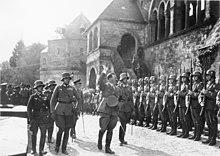
Soon after Hitler came to power, the city of Goslar became a showcase location for Nazi propaganda . Walther Darré made the decision to raise Goslar to the seat of the Reichsnährstand in 1934 and to the " Reichsbauernstadt " in 1936 . The development to the place of the Reichsbauernstand exhausted itself in forming the backdrop for the Reichsbauerntage that merged into the Heinrich cult; In addition, the region was increasingly industrialized and mining advanced with new technology.
In 1941 Goslar was reclassified from Prussia to the state of Braunschweig .
In addition, the city was the seat of armaments-related companies and institutions during the National Socialist era . The largest employers were the chemical factory Gebr. Borchers AG / HC Starck , the Unterharzer Berg- und Hüttenwerke GmbH and the Goslar air base . A total of around 5000 people from other European countries, mostly forced laborers, worked in the city and its surroundings during the Second World War; 61 companies made use of their labor during this period.
From 1940 to 1942 there was a subcamp of the Buchenwald concentration camp (camp number 255) to the north-west of the air base , in which up to 140 prisoners were housed. were used to work on the neighboring air base. A few hundred meters north of it existed between 1939 and 1945 the SS barrack camp Hahndorf , which housed a satellite camp of the Neuengamme concentration camp shortly before the end of the war .
The association "Spurensuche Harzregion e" is working on this chapter. V. The fate of the persecuted and deported Goslar Jews during the National Socialist era was also dealt with in a publication by Hans Donald Cramer.
Goslar survived the Second World War without major damage. Shortly before the city was captured by US units in April 1945, the city administration had Red Cross flags and signs reading “Lazarettstadt” installed in the main access roads. On April 10, 1945, the 329th Regiment of the 9th US Army advanced towards the city. The US units that were fired at from the city of Nordberg and Steinberg began to march into the outskirts. Two delegates from the town hall then made contact with some American officers. The Americans called for the German fighting to cease and for white flags to be hung up . After telephone contact with the Lord Mayor Goslars, the telephone exchange of the town hall began calling citizens to hang a white flag out of the windows. The US units were able to move into the city center without a fight. The city representatives carried out the handover of Goslar with US officers in the city hall that afternoon. Elsewhere in Germany, the war continued until the beginning of May. It finally ended on May 8th with the unconditional surrender of the Wehrmacht .
After 1945
After the end of the Second World War in 1945, Goslar belonged to the British zone of occupation . The British military administration set up a DP camp to accommodate so-called displaced persons (DP) , which was looked after by the UNRRA team 2913 .
The numerous refugees made an expansion of the city necessary. Its border location to the Soviet occupation zone hampered the trade, but on the other hand gave the city the zone border promotion and garrisons of the Federal Border Guard and the Bundeswehr .
From October 20-22, 1950, the CDU's first federal party conference took place in Goslar . The German CDU was founded there under the motto “Unity and Law and Freedom”; Konrad Adenauer was elected party chairman on October 21 with 302 votes out of 335. Goslar prevailed as a conference venue against Berlin, Frankfurt and Heidelberg.
In 1953, the great participation of the city of Goslar in the memorial service of the former Nazi Reichsbauernführer Walther Darré at the cemetery Hildesheimer Strasse on September 9, 1953 was remarkable : In addition to former Nazi greats such as Hartwig von Rheden , several hundred Goslar citizens, but also their Lord Mayor Alexander , attended Grundner-Culemann attended the funeral with Chief City Director Helmut Schneider. The city even paid for the funeral expenses.
The first southern European guest workers came to Goslar in the 1960s and 1970s . They mainly worked at the men's clothing works in Odermark and the 'Unterharzer Berg- und Hüttenwerke', later Preussag AG Metall.
In 1979 Goslar lost its status as an independent city when it became part of the Goslar district . With the opening of the border in 1989 and reunification in 1990, Goslar moved back more to the center of Germany.
The ore mine in Rammelsberg ( 635 m above sea level ) was closed in 1988. Thanks to the efforts of individual citizens and the monument protection authorities, it has been possible to keep the mine almost true to the original and to expand it into a museum. The responsible district curator at the time, Reinhard Roseneck, also worked out an application to recognize the Rammelsberg ore mine together with the old town of Goslar as a World Heritage Site ; this was then accepted by the World Heritage Committee in 1992. In 2010, the world cultural heritage was expanded to include the various systems of the Upper Harz water shelf .
The two barracks of the Federal Border Police closed in the mid-1990s. The French barracks were also given up.
On September 23, 2008, the city received the title “ Place of Diversity ”.
In 2010 the Bundeswehr barracks was also closed. On June 17, 2010, the 'Energy Research Center Lower Saxony on the Energy Campus Goslar' was opened in the former Rammelsberg barracks .
In July 2017, Goslar experienced the strongest flood in decades. According to Lord Mayor Oliver Junk, the city has "not experienced such a dramatic flood situation ... for 70 or 80 years".
Incorporations
On July 1, 1972, the city of Oker and the communities of Hahndorf, Hahnenklee-Bockswiese and Jerstedt were incorporated.
On January 1, 2014, the city of Vienenburg (with the districts Immenrode, Lengde, Lochtum, Weddingen and Wiedelah) was incorporated into the city of Goslar.
Population development
Goslar before 2014 without Vienenburg:
|
|
|
|
(From 1968 as of December 31st) The number of inhabitants of the city of Goslar according to their respective territorial status rose from 5482 to 8922 from 1821 to 1871. In 1939, 27,081 inhabitants were counted.
Territory as of January 1, 2014 including Vienenburg:
|
|
|
|
|
(from 1968 as of December 31st)
politics
City council
The council of the city of Goslar consists of 38 council women and councilors. The standard number for a parish with a population between 50,001 and 75,000 is 42 councilors. By resolution of the city council, this number has been reduced by four council members to 38 for the current electoral term. The council members are elected by local elections for a five-year term. The current electoral term begins on November 1, 2016 and ends on October 31, 2021.
The full-time mayor is also entitled to vote in the city council.
The local election on September 11, 2016 resulted in the following distribution of seats:
- SPD : 14 seats (−1)
- CDU : 10 seats (−5)
- AfD : 3 seats (+3)
- FDP : 3 seats (+1)
- Green : 3 seats (± 0)
- Goslarer Linke : 2 seats (−1)
- BGL : 2 seats (+2)
- AfG : 1 seat (+1)
- Citizens for Vienenburg : 0 seats (−2)
- Citizen list Goslar : 0 seats (−2)
The change to the local election on March 9, 2014 is shown in brackets.
mayor
The full-time Lord Mayor of the city of Goslar is Oliver Junk (CDU). In the last mayoral election on September 11, 2011, he was supported by the CDU and elected with 45.1% of the vote. The turnout was 51.0%. Junk took office on November 1, 2011.
- Former mayor until 1921 mayor, from 1921 mayor
|
|
Coat of arms, flag and banner
| Banner, coat of arms and hoisting flag | |

|
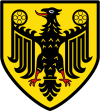
|

|
|
Blazon : The city's coat of arms shows a black, red-armored eagle on a golden background.
The coat of arms can be traced back to the middle of the 14th century. But a century earlier there were seals of the city that used the eagle. The eagle is the heraldic animal of the emperor and the empire. Goslar has this coat of arms because the city has had an imperial palace since the 11th century and was therefore an imperial residence and has been an imperial free imperial city since 1290/1340.
The eagle is also mounted as a bronze sculpture on the fountain in the market square (copy, original in the museum).
The flag and banner have yellow-black stripes across or lengthways with the coat of arms in or above the middle.
Town twinning
There are partnerships with:
-
 Arcachon in France since 1965
Arcachon in France since 1965 -
 Windsor and Maidenhead in the UK since 1969
Windsor and Maidenhead in the UK since 1969 -
 Beroun in the Czech Republic since 1989
Beroun in the Czech Republic since 1989 -
 Brzeg in Poland since 2000
Brzeg in Poland since 2000 -
 Ra'anana in Israel since 2006 (friendship treaty)
Ra'anana in Israel since 2006 (friendship treaty)
Culture and sights
Buildings
- Romanesque imperial palace with Goslarer Kaiserstuhl
- Market square with Gothic town hall, in it the tribute hall
- Kaiserringhaus (former treasury building on the east side of the market square with Romanesque cellar vaults, the carillon with figure surround shows the laborious work of the miners in Rammelsberg)
- Zwinger (fortification tower with 6.5 meter thick walls from 1517, today a museum, restaurant and holiday apartments)
- Great Holy Cross (hospice from the Middle Ages)
- Small holy cross
- Cathedral vestibule (of the collegiate church of St. Simon and Judas, Goslar Cathedral )
- Kaiserworth (Gildehaus from 1494, now a hotel)
- St. Aegidien Chapel
- Breast cloth (patrician house from 1521)
- St. Annenhaus (oldest fully preserved half-timbered house from 1488)
- Siemenshaus (parent company of the Siemens industrial family from 1693)
- Lohmühle (early 16th century)
- Kemenate Röver (farm house with Romanesque basement)
- Evangelical market church of St. Cosmas and Damian
- Evangelical monastery church of St. Peter and Paul (Frankenberg)
- Evangelical Stephanikirche (baroque church)
- Evangelical new church St. Mariae in horto (pure Romanesque style)
- Catholic St. Jakobi Church , Romanesque church (1073), nave and choir Gothicized, Protestant since the Reformation, Catholic since 1803
- Klaus Chapel
- Evangelical-Free Church Christ Church , originally the chapel of the Leprosy Hospital St. Pankratius (13th century), today's building in 1750
- St. Georg Abbey ruins on the Georgenberg
- Baroque collegiate church St. Georg in Grauhof
- Riechenberg Monastery
- Wöltingerode Monastery
- Birthplace of Hermann Moritz von Sachsen
- City fortifications (with kennel and wide gate)
- Vienenburg station (oldest station building in Germany from 1840)
- Wiedelah moated castle
- Neo-Romanesque station building of Goslar station
- Neo-Romanesque building of the Ratsgymnasium Goslar
- Deer Pharmacy
- Odeon theater
- Ruin St. Petri on the Petersberg
- Gustav-Adolf-Stave Church in Hahnenklee
- Jewish cemetery in Glockengießerstrasse
- Troll monk , former monastery
- Rammelsberg barracks (1912–1914), today EnergieCampus Goslar
Monuments
- Klusfelsen with Klusteich on Petersberg
- Memorial for the fallen hunters of the Hanoverian Jäger Battalion No. 10 in the Franco-Prussian War at the Kahnteich
- Memorial to the fallen Goslar hunters in World War I on Thomaswall
- Monumental sculpture Reach for Freedom by Fritz Theilmann (Memorial for those returning from war in the Kaiserpfalz, 1955)
Museums
Selection:
- Goslar Museum : Sights of this city museum are the Romanesque Krodo altar of the former Goslar Cathedral or the Goslar Gospels from 1240 of the Neuwerk monastery.
- Exhibitions on the history of the traveling empire can be found in the Kaiserpfalz
- Mönchehaus-Museum for Modern Art
- Rammelsberg mining museum ( UNESCO World Heritage Site )
Theaters and cultural venues
- Kulturkraftwerk Harz Energie (regular cabaret, comedy, concerts, puppet theater)
- Theater3 (in the old town cinema Goslarer Theater )
- Locksmith's shop in the Rammelsberg World Heritage Site (occasional music and theater events)
The former Odeon Theater with more than 800 seats was initially temporarily closed in August 2012 due to fire protection regulations and further redevelopment requirements. On December 22, 2015, the city council decided to finally cease gaming operations due to the non-representable financing concept.
music
The Paul-Lincke-Ring has been awarded since 1955 to musicians who have made special contributions to German-language popular music. The lender was initially the municipality of Hahnenklee-Bockswiese, and since its incorporation (1972) has been the city of Goslar. The ring was awarded every two years from 1955 to 2015, and every year since 2016.
The International Concert Working Weeks have been held annually in Goslar since 1975. They are organized in cooperation with the Hanover University of Music and Drama . Students from all over the world receive two weeks of lessons from professors at the university. Many concerts during this time testify to the high level of the masterclasses.
The International Goslar Piano Days attract an international group of participants every year.
Regular events

- Award of the Goslarer Kaiserring :
The Kaiserring of the city of Goslar is one of the most important international art prizes . Since 1975, the city of Goslar and the “Association for the Promotion of Modern Art Goslar eV” have annually given the ideal award to contemporary and international artists. -
German Traffic
Court Day : Annual conference for road traffic law with over 1000 participants. - Goslarer Hansetage:
The basic idea of the Hanseatic League is revived through a large number of events. - International old town run:
traditional run over various distances through the historic old town. - Walpurgism market on the market square
- Walpurgis Night in the Hahnenklee district
- Goslar Days of Cabaret:
Annual cabaret festival in the week after Whitsun. - Schützen- und Volksfest:
The Goslarer Schützenfest on the 86,000 m² large Osterfeld is one of the largest in Lower Saxony (ranked among the 30 largest fair events in Germany), lasts ten days and always begins on the Friday before the first Monday in July. - Crafts market:
between the Great Holy Cross and Schuhhof, craftsmen offer handcrafted workpieces. - Old Town Festival:
Event in September with numerous stages in the city center. - Goslar Christmas Market:
Around 70 traders, artisans, confectioners, mulled wine hosts and restaurateurs offer a romantic pre-Christmas experience every year. The attraction is the Christmas forest, which is festively illuminated on the Schuhhof from numerous six to nine meter high spruce trees. - Press ball of the Goslarschen Zeitung:
The event takes place every two years, has a special motto and regularly has around 850 ball visitors, including numerous personalities from politics, business and trade. - Lower Saxony Energy Days (net):
Under the leadership of the Lower Saxony Energy Research Center , the Energy Days are intended to show the strengths and competencies of Lower Saxony in connection with innovations and energy. The interdisciplinary cooperation of the actors involved should develop new ideas, improve knowledge and technology transfer and initiate joint projects between companies, scientific institutions and specialist authorities.
Economy and Infrastructure
economy
Goslar is the seat of the following companies:
- Bornemann, development of GPS technologies
- Electrocycling , e-waste recycling company
- EuropTec, glass finishing
- Fels , building materials manufacturer
- HC Starck , company in the chemical and metallurgical industry with over 2,800 employees worldwide
- Harz-Metall , metal smelter operator and legal successor of the disused Harz ironworks of the former Preussag AG
- Med-X-Press, logistics for the pharmaceutical and health industry
- Norzinco , chemical company, producer of zinc oxide
- Oker chemistry, specialty chemicals
- pdv software, software development
- PDV systems, IT system house
- Rettig Germany , manufacturer of products for heat transfer
- Stöbich fire protection , manufacturer of fire protection products
- Sundolitt, manufacturer of polystyrene insulation materials
- tejo group of companies, furniture retail company
- Trinks , beverage wholesale
traffic
Private transport
Goslar is crossed in the north by the four-lane federal highway 6 , which offers a connection to the supra-regional highway traffic ( federal highway 36 ; Braunschweig - Bernburg (Saale) / Halle (Saale) ) via the federal highway 369, which is also located in the city . The federal highway 82 continues to the west in a 2 + 1 street layout and connects Goslar to the federal highway 7 at Seesen / Rhüden . Furthermore, the B 241 runs through the town and the B 498 begins in Goslar and leads through the Harz Mountains to Osterode .
Rail and bus transport
There are three train stations in Goslar; next to the Goslar train station near the city center there is one train station each in the districts of Oker and Vienenburg . The former stops in Odermark and Grauhof no longer exist today.
The railway lines run through the city area from Halle (Saale) via Vienenburg ( Halle – Vienenburg railway ) to Hildesheim and Hanover ( Hildesheim – Goslar railway ), from Braunschweig to Seesen / Kreiensen ( Neuekrug Hahausen – Goslar railway ) and via Oker to Bad Harzburg ( Oker – Bad Harzburg railway line ). From Goslar there are direct connections to Hanover, Braunschweig, Magdeburg, Halle (Saale) and Göttingen, and on weekends there are also individual trains to Berlin .
Stadtbus Goslar GmbH operates a city bus network consisting of six lines, Regionalbus Braunschweig GmbH maintains several connections to the surrounding area. Long-distance bus connections include Berlin , Magdeburg , Göttingen , Kassel , Dortmund , Essen and Düsseldorf can be reached without changing trains. There is a central bus station at Goslar train station .
education and Science
The Ratsgymnasium was probably built around 1528; the Christian-von-Dohm-Gymnasium has existed since 1804. The “Realschule Hoher Weg” and the “Realschule Goldene Aue”, located directly in the city, emerged from one of the oldest schools.
There are also two vocational schools in Goslar , the BBS 1 Goslar -Am Stadtgarten- and the vocational schools Goslar-Baßgeige / Seesen. The BBS 1 Goslar -Am Stadtgarten- is responsible for vocational training in the areas of economy and administration, health and IT in the district of Goslar. At the BBS bass violin, the school forms of technical college for design, social affairs and technology are represented. With a completed vocational training you can do the Abitur at the BOS.
On December 7, 2007, the symbolic foundation stone for the Energy Research Center Lower Saxony (EFZN), a scientific institution of the Clausthal University of Technology , was laid in Goslar . This was officially opened on June 17, 2010 after the renovation work on the EnergieCampus Goslar was completed. In 2009 the newly established “Fiber Optic Sensor Systems” department of the Fraunhofer Heinrich Hertz Institute Berlin started its work in Goslar.
The St. Jakobushaus Catholic Academy of the Hildesheim diocese is located on the Georgenberg . The house will be closed in summer 2021.
| Elementary schools | |
|
|
| High schools | |
|
|
| High schools | Vocational schools |
|
|
| Special schools | Other |
|
|
Sports
The Goslarer Sport Club (GSC), founded in 1908, dominates football . 2009, the first men's team achieved promotion to the Regional , currently the team occurs in the following the recent decline in 2016 division of. SV Glückauf Rammelsberg, VfL / TSKV Oker and FG Vienenburg / Wiedelah play in the district league (7th league), TSV Immenrode and VfL / TSKV Oker II in the district league .
The hockey department of GSC 08 became German runner-up in 1956. In 2009 the independent Goslarer Hockey Club 09 e. V. (GHC 09).
The jazz and modern dance group JETs from MTV Goslar became German champions in 2006 and 2007 and took part in the 2007 World Cup in New York .
The Judo-Karate-Club Sportschule Goslar e. V. offers inter alia Judo , Karate , Ju-Jitsu , Kendo , Aikido , and men's and women gymnastics. The club has existed since 1962 and has produced several well-known athletes.
The cycling club RC Germania Hahndorf, founded in 1905, played at times in the 1st Bundesliga and was able to regularly celebrate great successes at the German championship or the Lower Saxony championship.
The cycle path of the European route (D3) runs through Goslar as part of the European cycle path R1 .
media
The family-run printing and media company Krause, which publishes the daily Goslarsche Zeitung as well as the advertising paper extra , the monthly event magazine trend, as well as book and special publications , dominates the market in the town and district . The only competitors are the Harzer Panorama advertising papers ( Madsack publishing group ) and Harzer General-Anzeiger (Bauer publishing group).
Personalities

reception
Goslar is the namesake of the mineral goslarite found in the nearby Rammelsberg ore mine and named in 1845 by Wilhelm von Haidinger .
In 2008 the old town of Goslar and the Rammelsberg mine formed the motif of the 100 euro gold coins issued annually from the UNESCO World Heritage series .
Otto von Freising described Goslar as "the richest city in Saxony".
literature
- Carl Borchers: The old Goslar half-timbered building and its symbolic jewelry . Goslar 1938.
- Eduard Crusius : History of the city of Goslar. Verlag A. Sorge, Osterode 1842.
- Hansgeorg Engelke (Ed.): Goslar from the Reformation to the Revolution. Lectures at the history association. (= Contributions to the history of the city of Goslar. Volume 53). Publishing house for regional history, Bielefeld 2005.
- Werner Gottschalk: Chronicle of the City of Goslar: 919–1919; taking into account what is happening in the Reich or the country and the surrounding area of the city . Brumby, Goslar 1999, ISBN 3-934231-20-9 .
- Hans-Günther Griep: Goslar. The chronicle of events . (= Guide through Goslar. Volume 7). Verlag Goslarsche Zeitung Karl Krause, Goslar 1995.
- Carl-Hans Hauptmeyer, Jürgen Rund (ed.): Goslar and the city history. Research and Perspectives 1399–1999. (= Contributions to the history of the city of Goslar. Volume 48). Publishing house for regional history, Bielefeld 2001, ISBN 3-89534-349-8 . ( Review )
- Otmar Hesse : A European family with ties to Goslar and Quedlinburg. Countess Aurora von Königsmarck. Count Moritz of Saxony. George Sand. Self-published by Otmar Hesse, Goslar 2019, ISBN 978-3-00-062315-8 .
- Jens Kassner: Goslar in one day. A city tour. 2nd Edition. Lehmstedt Verlag, Leipzig 2014, ISBN 978-3-942473-58-3 .
- Stephan Kelichhaus: Goslar around 1600 . (= Göttingen research on regional history. Volume 6). Publishing house for regional history, Bielefeld 2003.
- Lutz Lehmann: Goslar: Geographical investigation of the middle town on the edge of the Harz. Inaugural dissertation. Free University of Berlin, 1963.
- Peter Schyga: Goslar 1918–1945. From the national city to the imperial peasant city of National Socialism. Publishing house for regional history, Bielefeld 1999, ISBN 3-89534-279-3 .
- Wolfgang Sobotta: A visit to the Goslar Mint . Ed .: Karl Krause (= Goslarer Bergkalender . 367th year). Goslarsche Zeitung, Goslar 1985, p. 123-128 .
Web links
- Official website of the city of Goslar
- UNESCO World Heritage in the Harz Mountains
- Entry on the website of the UNESCO World Heritage Center ( English and French ).
- The Rammelsberg and Goslar. Unesco World Heritage Site, with RealVideo (14 min.)
- The inscriptions of the city of Goslar
- Link catalog on Goslar at curlie.org (formerly DMOZ )
- Plan of the city of Goslar from 1880
Individual evidence
- ↑ State Office for Statistics Lower Saxony, LSN-Online regional database, Table 12411: Update of the population, as of December 31, 2019 ( help ).
- ↑ Population of the municipalities and districts of the Goslar district. Retrieved March 17, 2019.
- ↑ Lothar Klappauf : On the archeology of the resin. In: Reports on the preservation of monuments in Lower Saxony. Publication of the Lower Saxony State Administration Office - Institute for Monument Preservation, Hanover. Issue 4/1992.
- ^ Hans-Günther Griep: Small art history of the German town house. 2nd Edition. Scientific Book Society, Darmstadt 1992, p. 256.
- ^ Karl Heinrich Kaufhold, Ernst Schubert, Christoph Bartels, Heiner Lück, Carl-Hans Hauptmeyer, Martin Stöber, Hans-Joachim Kraschewski, Michael Fessner, Angelika Kroker: The Riechenberger contract . Ed .: Weltkulturerbe Rammelsberg / Rammelsberg Mining Museum Goslar (= Rammelsberger Forum . Volume 3 ). Goslarsche Zeitung, 2004, ISBN 3-9804749-8-4 , ISSN 1619-6503 , p. 78 .
- ↑ See BSLK , p. 765; see p. 17.
- ↑ Ingeborg Titz-Matuszak: Magic and witch trials in Goslar. In: Lower Saxony Yearbook for State History. No. 65 (1993), pp. 115-160.
- ^ Hans Gidion: Magister Hans Nendorf. In: Karl G. Bruchmann, Heinrich Spier (Ed.): Frölich-Festschrift. Karl Frölich on the completion of the 75th year of life on April 14, 1952 (= contributions to the history of the city of Goslar. Volume 13). Self-published by the History and Heritage Protection Association Goslar e. V., Goslar 1952, pp. 127-154.
- ↑ StA Goslar, B05974: Report by Mayor Henning Cramer von Clausbruch on the attacks by Duke Christian von Braunschweig-Lüneburg and the Swedish occupation , [1632].
- ^ Uvo Hölscher : Henning Cramer von Clausbruch. Mayor of the city of Goslar 1626–1646. In: Harz. Journal for the Harz Association 40. (1907), pp. 2-52.
- ↑ Angelika Kroker: So make such a democratiam. Conflict and reform efforts in the imperial city regiment of Goslar 1666–1682 (= contributions to the history of the city of Goslar. Volume 50). Publishing house for regional history, Bielefeld 2001.
- ↑ Quotation from Gottschalk, 1999, 406.
- ↑ Quoted from: Heinrich Heine: Die Harzreise and other travel pictures . German Library Berlin n.d., p. 32.
- ^ Ordinance on territorial adjustments in the area of the Hermann-Göring-Werke Salzgitter.
- ↑ aussenlager.buchenwald.de ( Memento from February 2, 2015 in the Internet Archive )
- ↑ Hans Donald Cramer: The fate of the Goslar Jews 1933-1945. A documentation (= contributions to the history of the city of Goslar. Volume 36). Self-published by the History and Homeland Protection Association Goslar e. V., Goslar 1986.
- ↑ a b c Manfred Bornemann : Fateful Days in the Harz Mountains. Clausthal-Zellerfeld 1974, section: Tuesday, April 10, 1945; Compare there
- ↑ Goslar. Goslar's city history , accessed on: October 16, 2019.
- ↑ Hamburg senior citizens office. Zero hour in Goslar (1945) , accessed on: October 16, 2019.
- ^ The first party congress of the CDU. In: www.kas.de. Retrieved October 14, 2014 .
- ↑ Donald Giesecke: Goslar 1945 to 1953. In: Our Harz, history and stories, culture and nature from the entire Harz. Clausthal-Zellerfeld, issue 7/2018.
- ↑ goslarer-geschichten.de
- ↑ Festschrift (pdf)
- ↑ Goslar calls out a disaster alarm - evacuations in Lower Saxony. In: www.focus.de.
- ^ Federal Statistical Office (ed.): Historical municipality directory for the Federal Republic of Germany. Name, border and key number changes in municipalities, counties and administrative districts from May 27, 1970 to December 31, 1982 . W. Kohlhammer, Stuttgart / Mainz 1983, ISBN 3-17-003263-1 , p. 266 .
- ↑ Lower Saxony State Chancellery (ed.): Law on the Unification of the Cities of Vienenburg and Goslar, District of Goslar . Lower Saxony Law and Ordinance Gazette (Nds. GVBl.). No. 10/2013 . Hanover June 19, 2013, p. 163 ( digitized version ( memento from September 26, 2018 in the Internet Archive ) [PDF; 153 kB ; accessed on August 21, 2019] p. 7).
- ↑ State Office for Statistics and Communication Technology Lower Saxony. Retrieved May 19, 2013 .
- ^ Lower Saxony Yearbook for State History: Organ of the Historical Association for Lower Saxony in Hanover . Hahn, 2002 ( books.google.com ).
- ↑ Jochen Kothe: DigiZeitschriften: Side view. In: www.digizeitschriften.de. Retrieved March 5, 2016 .
- ↑ State Office for Statistics and Communication Technology Lower Saxony. Retrieved March 5, 2016 .
- ^ Website of the communal data processing in Oldenburg. Retrieved September 29, 2016.
- ^ Lower Saxony Municipal Constitutional Law (NKomVG); Section 46 - Number of Deputies. In: Internet site for the Lower Saxony Regulation Information System (NI-VORIS). December 17, 2010, accessed September 18, 2019 .
- ↑ Individual results of the 2011 direct elections in Lower Saxony. ( Memento of December 26, 2014 in the Internet Archive ) Retrieved February 7, 2015.
- ^ Flag of Goslar
- ↑ Website of the former Odeon Theater Goslar
- ^ Website of the International Concert Working Weeks Goslar
- ↑ Simon Benne diocese closes educational institutions , in Hannoversche Allgemeine Zeitung, November 27, 2020 p. 7
- ^ Wilhelm Haidinger : Handbook of determining mineralogy: containing the terminology, systematics, nomenclature and characteristics of the natural history of the mineral kingdom . 2nd Edition. Braumüller & Seidel Verlag, Vienna 1845, p. 490 ( available online in the Handbook of Determining Mineralogy, p. 490 in the Google book search).
- ↑ Mineral Atlas: Goslarite
- ↑ Berent Schwineköper: On the problem of terms such as Staufer cities, Zähringer cities and similar names in the Southwest German working group for urban history research. In: Erich Maschke, Jürgen Sydow: Southwest German cities in the age of the Hohenstaufen. 1980, ISBN 3-7995-6406-3 , p. 55.
- ^ W. Hillebrand: City history [of Goslar]. In: Guide to Prehistoric and Protohistoric Monuments. Volume 35, Philipp von Zabern, Mainz 1978, ISBN 3-8053-0304-1 , p. 51.







